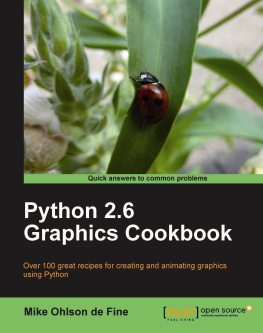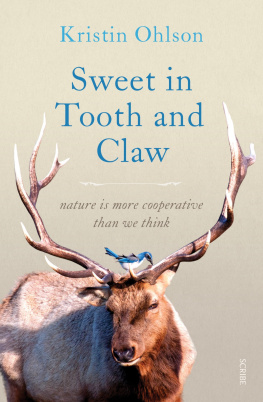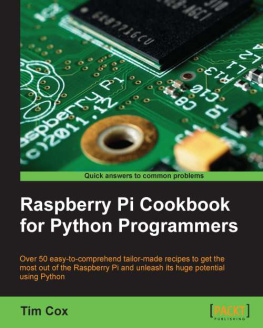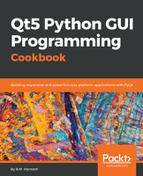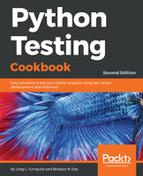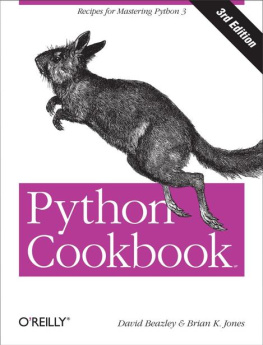Mike Ohlson de Fine - Python 2.6 Graphics Cookbook
Here you can read online Mike Ohlson de Fine - Python 2.6 Graphics Cookbook full text of the book (entire story) in english for free. Download pdf and epub, get meaning, cover and reviews about this ebook. year: 2018, publisher: Packt Publishing, genre: Computer. Description of the work, (preface) as well as reviews are available. Best literature library LitArk.com created for fans of good reading and offers a wide selection of genres:
Romance novel
Science fiction
Adventure
Detective
Science
History
Home and family
Prose
Art
Politics
Computer
Non-fiction
Religion
Business
Children
Humor
Choose a favorite category and find really read worthwhile books. Enjoy immersion in the world of imagination, feel the emotions of the characters or learn something new for yourself, make an fascinating discovery.
- Book:Python 2.6 Graphics Cookbook
- Author:
- Publisher:Packt Publishing
- Genre:
- Year:2018
- Rating:3 / 5
- Favourites:Add to favourites
- Your mark:
- 60
- 1
- 2
- 3
- 4
- 5
Python 2.6 Graphics Cookbook: summary, description and annotation
We offer to read an annotation, description, summary or preface (depends on what the author of the book "Python 2.6 Graphics Cookbook" wrote himself). If you haven't found the necessary information about the book — write in the comments, we will try to find it.
Python 2.6 Graphics Cookbook — read online for free the complete book (whole text) full work
Below is the text of the book, divided by pages. System saving the place of the last page read, allows you to conveniently read the book "Python 2.6 Graphics Cookbook" online for free, without having to search again every time where you left off. Put a bookmark, and you can go to the page where you finished reading at any time.
Font size:
Interval:
Bookmark:
Copyright 2010 Packt Publishing
All rights reserved. No part of this book may be reproduced, stored in a retrieval system, or transmitted in any form or by any means, without the prior written permission of the publisher, except in the case of brief quotations embedded in critical articles or reviews.
Every effort has been made in the preparation of this book to ensure the accuracy of the information presented. However, the information contained in this book is sold without warranty, either express or implied. Neither the author, nor Packt Publishing, and its dealers and distributors will be held liable for any damages caused or alleged to be caused directly or indirectly by this book.
Packt Publishing has endeavored to provide trademark information about all of the companies and products mentioned in this book by the appropriate use of capitals. However, Packt Publishing cannot guarantee the accuracy of this information.
First published: November, 2010
Production Reference: 1181110
Published by Packt Publishing Ltd. 32 Lincoln Road Olton Birmingham, B27 6PA, UK.
ISBN 978-1-849513-84-5
www.packtpub.com
Cover Image by Asher Wishkerman (<>)
Author
Mike Ohlson de Fine
Reviewers
Flavio Barbosa
Michael Driscoll
Warren Noronha
Acquisition Editor
Dilip Venkatesh
Development Editor
Meeta Rajani
Technical Editor
Gauri Iyer
Indexer
Tejal Daruwale
Editorial Team Leader
Mithun Sehgal
Project Team Leader
Ashwin Shetty
Project Coordinator
Michelle Quadros
Proofreader
Mario Cecere
Graphics
Nilesh R. Mohite
Production Coordinator
Aparna Bhagat
Cover Work
Aparna Bhagat
Mike Ohlson de Fine is a graduate Electrical Engineer specializing in industrial process measurement and control. He has a Diploma in Electronics and Instrumentation from Technikon Witwatersrand, an Electrical Engineering degree from the University of Cape Town, and a Masters in Automatic Control from Rand Afrikaans University. He has worked for mining and mineral extraction companies for the last 30 years. His first encounter with computers was learning Fortran 4 using punched cards on an IBM 360 as an undergraduate. Since then, he has experimented with Pascal, Forth, Intel 8080 Assembler, MS Basic, C, and C++, but was never satisfied with any of these. Always restricted by corporate control of computing activities, he encountered Linux in 2006 and Python in 2007 and became free at last.
As a working engineer he needs tools that facilitate the understanding and solution of industrial process control problems using simulations and computer models of real processes. Linux and Python proved to be excellent tools for these challenges. When he retires he would like to be part of setting up a Free and Open Source engineering virtual workshop for his countrymen and people in other poor countries to enable the bright youngsters of these countries to be intellectually free at last.
His hobbies are writing computer simulations, paddling kayaks in wild water, and surf skiing in the sea.
At the top of the pyramid of people who have helped and encouraged me to write this book is my wonderful wife Suzanne. Thank you Suzy, with all my heart. I want to dedicate this book also to three courageous people, Genevieve, Candace, and Peter, who have bravely chosen a steep and difficult path in their lives. I salute you.
Next who I would like to thank are the very professional and pleasant staff of PACKT Publishing. A special thanks to the restrained and long suffering reviewers Mike Driscoll, Warren Noronha, and Flavio Barbosa. Your criticism was invaluable.
Michael Driscoll has been programming Python since 2006 and has dabbled in other languages since the late nineties. He graduated from university with a Bachelors in Science degree, majoring in Management Information Systems. Michael enjoys programming for fun and profit. His hobbies include Biblical apologetics, blogging about Python at http://www.blog.pythonlibrary.org/ and learning photography. Michael currently works for local government where he programs with Python as much as possible. Michael was also a technical editor for Python 3: Object Oriented Programming by Dusty Phillips.
I would like to thank my brothers for their support and the fun times they share with me and my dad for his indirect support. Most of all, I want to thank Jesus for saving me from myself.
Warren Noronha is an entrepreneur and geek. Computers have been part of Warrens life since he was four years old. He began his career as a system administrator, but ended up doing everything from security and design to product development. He enjoys managing people as much as he does managing code or machines. Having worked with small startups as well as Fortune 500 companies, Warren is also a staunch supporter of free software and free speech. He has been a frequent speaker at various colleges and events, discussing subjects ranging from technology and media to launching a startup.
Warren loves working with new technologies; a trait which lead him to become one of the first users of GNU/Linux, Drupal, and Ruby on Rails, much before they grew exponentially and became mainstream technologies. He spends his time working on databases, distributed computing, social computing, and enjoys using internet and communication technology to bridge the digital divide.
Python 2.6 Graphics Cookbook is a collection of straightforward recipes and illustrative screenshots for creating and animating graphic objects using the Python language. This book makes the process of developing graphics interesting and entertaining by working in a graphic workspace, without the burden of mastering complicated language definitions and opaque examples.
, Start your Engines: This chapter explains how to acquire and install the Python interpreter, for MS Windows or Linux as well as how to verify that Python is correctly installed. This chapter explains how to create complete working programs that can be run on client computers that do not have Python installed.
, Drawing Fundamental Shapes: This shows how to create all the fundamental graphic elements including lines, circles, ovals, rectangles, polygons, and complex curves. Simple examples are provided to demonstrate how to draw the elementary shapes. The examples also provide a ready for reference for later use.
, Handling Text: This chapter demonstrates how to control font size, color, and position using any of the font typefaces installed on the specific operating system being used. A simple means of discovering and demonstrating all available fonts on the operating system is shown.
, Animation Principles: This chapter starts with examples of simple sequences of a circle in different positions and systematically progresses to smoothly-moving animations of elastic balls bouncing inside a gravity field.
, The Magic of Color: This chapter begins with the assembling of color palettes using color names recognizable to Python. The way colors are constructed using numbers to mix controlled amounts of red, green, and blue is explained. Tools for matching colors to any sample are constructed. This chapter demonstrates how to vary shadings of one color into another.
Font size:
Interval:
Bookmark:
Similar books «Python 2.6 Graphics Cookbook»
Look at similar books to Python 2.6 Graphics Cookbook. We have selected literature similar in name and meaning in the hope of providing readers with more options to find new, interesting, not yet read works.
Discussion, reviews of the book Python 2.6 Graphics Cookbook and just readers' own opinions. Leave your comments, write what you think about the work, its meaning or the main characters. Specify what exactly you liked and what you didn't like, and why you think so.

